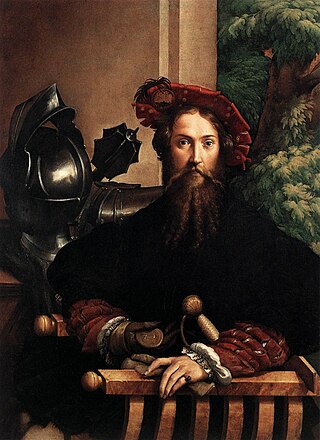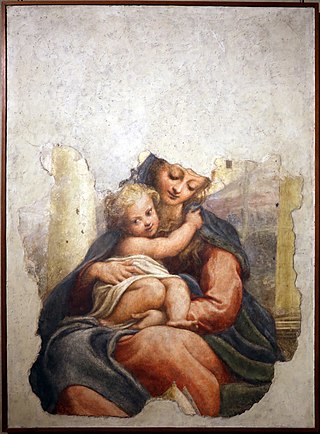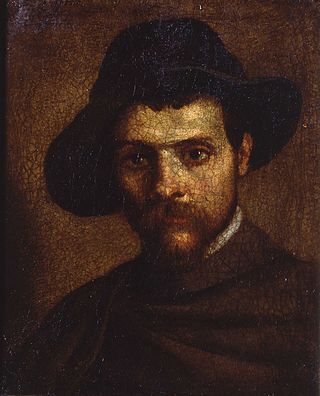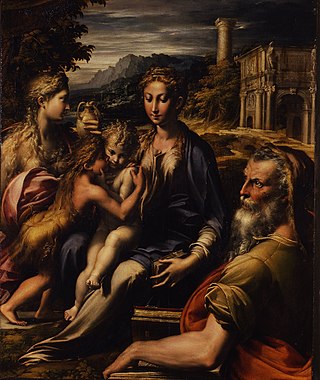
Antonio Allegri da Correggio, usually known as just Correggio was an Italian Renaissance painter who was the foremost painter of the Parma school of the High Renaissance, who was responsible for some of the most vigorous and sensuous works of the sixteenth century. In his use of dynamic composition, illusionistic perspective and dramatic foreshortening, Correggio prefigured the Baroque art of the seventeenth century and the Rococo art of the eighteenth century. He is considered a master of chiaroscuro.

Girolamo Francesco Maria Mazzola, also known as Francesco Mazzola or, more commonly, as Parmigianino, was an Italian Mannerist painter and printmaker active in Florence, Rome, Bologna, and his native city of Parma. His work is characterized by a "refined sensuality" and often elongation of forms and includes Vision of Saint Jerome (1527) and the iconic if somewhat anomalous Madonna with the Long Neck (1534), and he remains the best known artist of the first generation whose whole careers fall into the Mannerist period.

Museo di Capodimonte is an art museum located in the Palace of Capodimonte, a grand Bourbon palazzo in Naples, Italy designed by Giovanni Antonio Medrano. The museum is the prime repository of Neapolitan painting and decorative art, with several important works from other Italian schools of painting, and some important ancient Roman sculptures. It is one of the largest museums in Italy. The museum was inaugurated in 1957.

Portrait of Galeazzo Sanvitale (1524) is a painting of the condottiero Gian Galeazzo Sanvitale by the Italian late Renaissance artist Parmigianino. It is housed in the National Museum of Capodimonte, Naples, Italy.

San Giovanni Evangelista is a Mannerist-style, Roman Catholic church located on Piazzale San Giovanni, located just behind the apse of the Parma Cathedral, in the historic center of Parma, northern Italy. The buildings surrounding the piazza were also part of a former Benedictine convent. The church is notable for its Correggio frescoes.

La Scapigliata is an unfinished painting generally attributed to the Italian High Renaissance artist Leonardo da Vinci, and dated c. 1506–1508. Painted in oil, umber, and white lead pigments on a small poplar wood panel, its attribution remains controversial, with several experts attributing the work to a pupil of Leonardo. The painting has been admired for its captivating beauty, mysterious demeanor, and mastery of sfumato.

Turkish Slave, also called Portrait of a Young Woman, is a painting by the Italian Mannerist artist Parmigianino. The painting was executed around 1533. It is housed in the Galleria nazionale di Parma.

The Madonna of the Stairs is a fresco fragment by the Italian Renaissance artist Correggio, dating to ca.1522–23 and now in the Galleria Nazionale di Parma.

The Mystic Marriage of St Catherine is a c.1529 oil on panel painting of the mystical marriage of Saint Catherine by Parmigianino, now in the National Gallery, London, who acquired it in 1974. It was engraved by Giulio Bonasone.

Holy Family with the Infant Saint John the Baptist is a painting by Parmigianino, executed c. 1528. It was in the Palazzo Farnese in Rome until 1662, when it moved to Parma. There it hung in the Palazzo del Giardino and later in the Galleria Ducale - the 'Descrizione' of the latter in 1725 called it one of the finest works on display there. It and the rest of the Farnese collection were later moved to Naples and the work was exhibited for a few years in the Palazzo Reale before moving to its present home in the National Museum of Capodimonte. Two early copies remain in the Galleria Nazionale and Palazzo Comunale in Parma.

Pope Paul III with a Nephew is an unfinished 1534 oil on slate portrait by Sebastiano del Piombo, now in the Galleria nazionale di Parma. The nephew's identity is unclear but the painting's presumed date suggests it may be Ottavio Farnese, whom Pope Paul III made Duke of Parma and Piacenza soon after the work's date

Mystic Marriage of Saint Catherine or Mystic Betrothal of Saint Catherine is a c.1524 oil on canvas painting by the Italian Renaissance painter Parmigianino. The work is now in the Galleria nazionale di Parma. Art historians argue that the work may be attributed to the period in which Parmigianino was painting his first works in the church of San Giovanni Evangelista, as also emerges from a recent restoration, which has shown that its technique is near-identical to that of Parmigianino - "no underdrawing, pigment use, descriptive speed, drafting of final shadows, using fingers and brush-ends as tools".

Portrait of a Young Man is an oil on panel painting by Parmigianino, executed c. 1530, now in the Uffizi in Florence, whose collection it entered on 27 October 1682. Three copies survive in the Museo di Capodimonte, Rome's Accademia di San Luca and the Galleria nazionale di Parma.

Lucretia is a 1540 oil on panel painting of Lucretia by Parmigianino, originally in the Farnese collection and now in the Museo nazionale di Capodimonte in Naples.

Female Martyr with Two Angels is a c.1523-1524 oil on panel painting by Parmigianino, now in the Städel Museum in Frankfurt, to which it was donated in 1913 by Baroness Emilie Margarethe Beaulieu-Marconnay, member of a family of bankers and art patrons in the city.

Man Holding a Book or Man with a Book is an oil on panel painting by Parmigianino, executed c. 1529, now in the Kunsthistorisches Museum in Vienna.

Self-Portrait is a 1593 oil on canvas painting by Annibale Carracci, now in the Galleria Nazionale di Parma. It is dated 17 April 1593 on the top left of the canvas.

Madonna and Child with Saints is an oil on canvas painting by Agostino Carracci, from 1585, dated on the lowest step of the Virgin Mary's throne. An example of a sacra conversazione. Long in the Benedictine abbey of San Paolo in Parma, French troops took it to Paris in 1796 and on its return to Italy in 1816 it was moved to the Galleria nazionale di Parma, where it still hangs.

The Casalmaggiore Altarpiece is a 1540 oil on panel painting by Parmigianino, now in the Gemäldegalerie in Dresden, which acquired it from the Este collection in 1746.

Madonna and Child with Saint Zechariah is a c.1530–1533 oil on panel painting by Parmigianino, now in the Uffizi. It shows the Madonna and Child with Zechariah, father of John the Baptist.




















